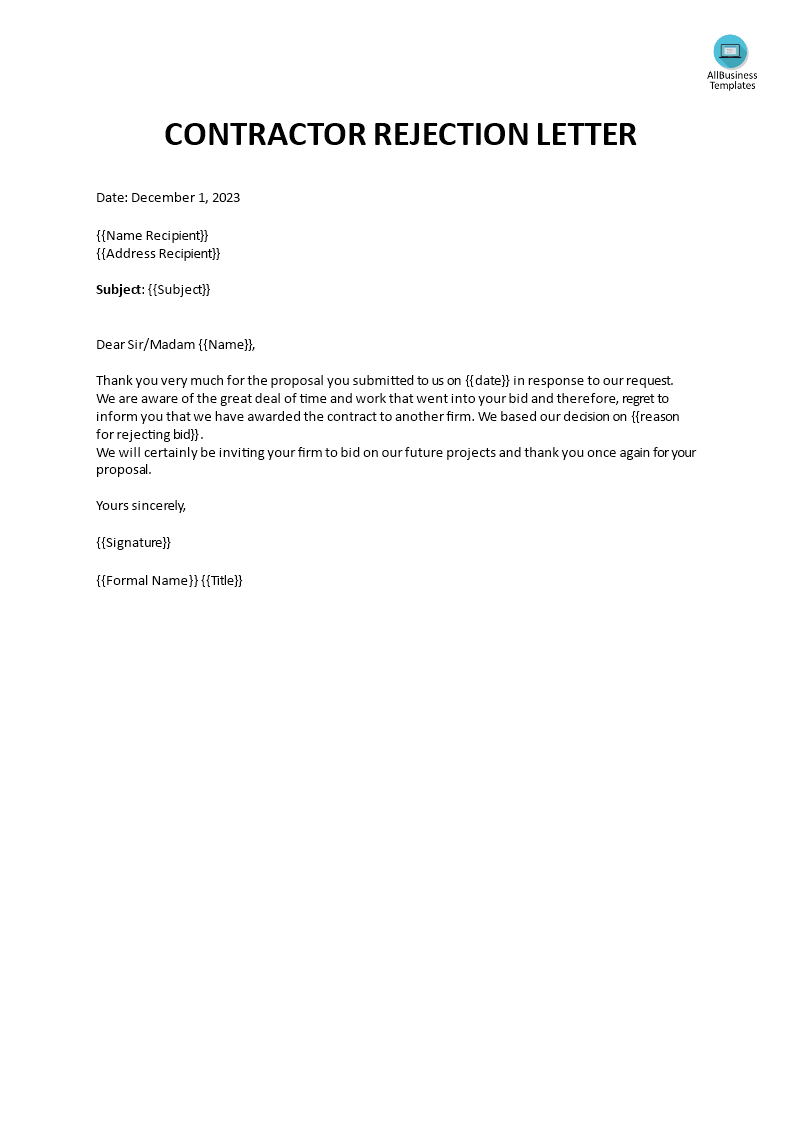Contractor Rejection Letter
Save, fill-In The Blanks, Print, Done!

Download Contractor Rejection Letter
Microsoft Word (.docx)Or select the format you want and we convert it for you for free:
- This Document Has Been Certified by a Professional
- 100% customizable
- This is a digital download (26.52 kB)
- Language: English
- We recommend downloading this file onto your computer.
How to create a contractor rejection letter? What is the process for rejecting a contractor's proposal?
This letter can be used to inform a contractor that their offer for a contract has been rejected. It should include the reason for the rejection and any next steps that the contractor should take. An easy way to start completing your document is to download this example letter template now!
A Contractor Rejection Letter is a formal document used by individuals or organizations to inform a contractor that their bid or proposal for a project has been rejected. This letter is typically sent after a thorough evaluation of the contractor's submission and a decision has been made not to award them the contract.
The letter usually includes the reasons for the rejection, such as non-compliance with project requirements, budget constraints, a more competitive proposal from another contractor, or other specific factors. It is essential to maintain a professional and respectful tone in the rejection letter, as the goal is to communicate the decision clearly without damaging the relationship with the contractor.
Key components of a Contractor Rejection Letter may include:
- Header: The letter should include the name and address of both the issuing party and the contractor.
- Date: The date on which the rejection letter is written.
- Salutation: A formal greeting addressing the contractor.
- Introduction: A brief introduction expressing appreciation for the contractor's effort and interest in the project.
- Reasons for Rejection: A clear and concise explanation of the reasons for the rejection. This may include specific details about why the contractor's bid or proposal did not meet the project requirements or criteria.
- Appreciation: Despite the rejection, expressing gratitude for the time and effort the contractor invested in the bidding process.
- Encouragement: If applicable, offering encouragement for the contractor to participate in future bidding opportunities.
- Closing: A courteous closing remark and an invitation for the contractor to contact the issuer if they have any questions or require further clarification.
Remember, maintaining professionalism and transparency in the rejection letter is crucial to preserving a positive relationship with the contractor and leaving the door open for potential future collaborations.
Download this template now for your own benefit!
DISCLAIMER
Nothing on this site shall be considered legal advice and no attorney-client relationship is established.
Leave a Reply. If you have any questions or remarks, feel free to post them below.
Related templates
Latest templates
Latest topics
- Flyer Template
Creating strong marketing materials that support your marketing strategy, such as flyers or online promotion (banners, ads) are an important part of growing a successful business! - Hourly Weekly Schedule Template
How do I make an hourly schedule? Streamline your daily planning with our versatile hourly daily weekly schedule templates - Excel Templates
Where do I find templates for Excel? How do I create a template in Excel? Check these editable and printable Excel Templates and download them directly! - GDPR Compliance Templates
What do you need to become GDPR compliant? Are you looking for useful GDPR document templates to make you compliant? All these compliance documents will be available to download instantly... - Daily Report Sheets For Preschool
How do you create a kindergarten schedule or write a daily report for a preschool? Check out these preschool templates here.
cheese

